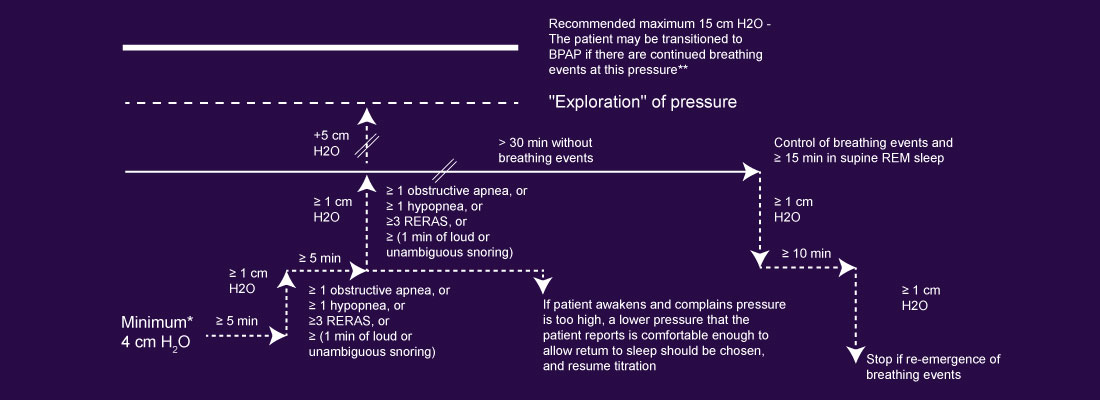Introduction
If you’ve discussed issues related to fatigue and disrupted sleep with your healthcare provider, they have likely suggested or arranged a sleep study for you. However, this study is where you would obtain a diagnosis and assess the extent of your sleep apnea, whether mild or severe. Following the sleep study, your healthcare provider will analyze the results and decide on the most suitable treatment plan. If you are diagnosed with sleep apnea, the sleep lab may schedule you for a CPAP titration study.
CPAP titration involves utilizing a Continuous Positive Airway Pressure (CPAP) machine to identify the optimal pressure setting for managing your Obstructive Sleep Apnea. During this process, your sleep technician will assess different pressures, aiming to determine the minimum setting at which you encounter the fewest apnea events, such as choking, temporary cessation of breathing for up to ten seconds, and gasping for air.
The titration conducted concurrently with your sleep study is a split-night sleep study, generally reserved for Severe Obstructive Sleep Apnea cases. Typically, a distinct titration study is arranged for a later date, allowing your healthcare provider adequate time to assess the findings from your sleep study.
This blog explores oxygen titration by CPAP, addressing queries such as, “What does titration of CPAP entail? How is titration conducted? What sets this titration apart from a sleep study?” and more. If you want to understand oxygen titration through CPAP better and seek additional information, continue reading.
What Is Titration by CPAP?
CPAP titration involves determining the minimum flow rate needed to keep your airway open through Continuous Positive Airway Pressure (CPAP). However, during this process, your sleep technician will manually assess various therapy pressures to identify the optimal setting that reduces your sleep apnea symptoms. Additionally, this ensures you can sleep through the night without experiencing episodes of waking up choking or gasping for air.
Following your sleep study, the healthcare provider typically schedules a distinct appointment for oxygen titration. Furthermore, this allows your healthcare provider the necessary time to thoroughly review and evaluate your results before proposing any additional steps. In cases where Severe Obstructive Sleep Apnea is a concern, a split-night study may occur, incorporating titration after the initial hours of the sleep study. However, split-night research might need more time for symptoms to manifest for those with mild sleep apnea. Therefore, healthcare professionals usually schedule a separate titration study a few days later.
CPAP Titration Study Algorithm For Patients

For patients under the age of 12 undergoing complete or split-night titration studies, the CPAP titration algorithm involves incremental adjustments of at least 1 cm over periods of at least 5 minutes. However, the titration continues until a minimum of 30 minutes without breathing events is achieved. A higher initial CPAP may be chosen in cases of an elevated BMI or retitration studies. Additionally, if a patient experiences discomfort or intolerance with high CPAP, trying BiPAP is recommended.
Ways of CPAP Titration
There are two ways in which you can perform a titration.
In-Lab Titration Studies:
During a traditional CPAP titration, healthcare providers closely monitor patients in a sleep lab, adjusting the CPAP machine settings as needed. However, sleep technicians meticulously fine-tune the pressure levels to find the point of optimal efficacy.
Home-Based Titration:
Advancements in technology have introduced home-based titration studies, allowing individuals to undergo the titration process in the comfort of their homes. Additionally, remote monitoring and adjustments enhance convenience and reduce the need for multiple in-lab visits.
Auto-Adjusting CPAP: The Adaptive Solution:
Definition and Mechanism:
Auto-adjusting CPAP, often called APAP (Auto-Adjusting Positive Airway Pressure), is a dynamic solution that adapts to the user’s breathing patterns in real-time. These devices use algorithms to assess the individual’s airflow needs throughout the night, automatically adjusting the pressure settings accordingly.
How Auto-Adjusting CPAP Works:
Algorithmic Intelligence:
Auto-adjusting CPAP devices utilize sophisticated algorithms that analyze breathing patterns and detect changes in airway resistance. Moreover, this real-time assessment allows the device to modulate pressure levels as needed, providing a customized and adaptive therapeutic response.
Flexibility and Comfort:
Auto-adjusting CPAP offers a level of flexibility not found in traditional titration. However, responding dynamically to variations in airflow requirements can enhance user comfort and compliance.
Critical Considerations in Choosing Between CPAP Titration and Auto-Adjusting CPAP
Individual Variability:
Consistency vs. Flexibility:
CPAP titration provides a fixed pressure setting determined during the titration study. While this offers consistency, it may not account for night-to-night variability in breathing patterns. On the other hand, auto-adjusting CPAP offers adaptability to changing needs and accommodates variations in sleep stages and positions.
Diagnostic Precision:
Titration for Complex Cases:
In cases where sleep apnea is complex or comorbid conditions are present, in-lab titration studies provide a thorough diagnostic assessment. However, the controlled environment of a sleep lab allows for precise adjustments and comprehensive monitoring.
Simplicity for Routine Cases:
Auto-adjusting CPAP can offer a simplified and efficient solution for individuals with straightforward sleep apnea cases and precise diagnostic profiles. However, the adaptability of auto-adjusting devices can address typical variations in airflow without needing in-lab titration.
Advantages and Challenges of Each Approach
Advantages of Oxygen Titration Through CPAP:
Precision in Pressure Setting:
CPAP titration accurately determines the optimal pressure needed to maintain airway patency. Moreover, this can be particularly beneficial in cases requiring meticulous pressure adjustments.
Diagnostic Insights:
In-lab titration studies provide valuable diagnostic insights beyond pressure settings, allowing healthcare professionals to monitor sleep architecture, identify respiratory events, and assess overall sleep quality.
Advantages of Auto-Adjusting CPAP:
Adaptive Comfort:
Auto-adjusting CPAP devices offer a more adaptive and comfortable experience. Additionally, responding to changing conditions throughout the night enhances user comfort and may improve adherence to therapy.
Reduced Need for Follow-Up Titration:
For individuals using auto-adjusting CPAP, the continuous adaptability minimizes the need for follow-up in-lab titration studies, offering a more streamlined and convenient approach to therapy nonetheless.
Challenges and Considerations:
Titration Challenges:
CPAP titration may pose challenges, including the inconvenience of in-lab studies, potential discomfort associated with multiple pressure adjustments, and the need for follow-up titration in some instances.
Adaptability Limits:
While auto-adjusting CPAP is adept at adapting to changing conditions, there may be situations where a fixed pressure setting determined through titration is preferable, especially in specific medical conditions.
Making an Informed Decision
Collaborative Decision-Making:
Healthcare Professional Guidance:
Consult with a healthcare professional to decide between CPAP titration and auto-adjusting CPAP. Factors such as medical history, sleep study results, and individual preferences are pivotal in determining the most suitable approach.
User Preferences and Lifestyle:
Convenience and Lifestyle Factors:
Considerations such as lifestyle, travel frequency, and user preferences play a role in decision-making. Some individuals may prioritize the adaptability of auto-adjusting CPAP, while others may value the precision of CPAP titration.
Future Trends and Technological Advancements
Telemedicine and Remote Monitoring:
Advancements in Home-Based Titration:
Telemedicine and remote monitoring technologies are shaping the future of sleep medicine. Home-based titration studies, facilitated by telehealth platforms, are becoming more prevalent, offering individuals greater accessibility and reducing the need for in-lab visits.
Personalized Therapy Solutions:
Integration of Artificial Intelligence:
Integrating artificial intelligence (AI) in sleep apnea therapy is on the horizon. AI-driven algorithms may further enhance the personalization of therapy, tailoring treatment plans to individual responses and optimizing long-term outcomes.
Conclusion
In the dynamic landscape of sleep apnea treatment, the choice between CPAP titration and auto-adjusting CPAP reflects a balance between precision and adaptability. However, the journey toward optimal sleep health involves collaborative decision-making guided by healthcare professionals, individual preferences, and technological advancements. As individuals embark on this path, armed with knowledge and insights, they navigate towards a tailored and effective sleep apnea management strategy that aligns seamlessly with their unique needs and lifestyles.
Key Takeaways:
Considerations in Choosing:
Individual variability plays a crucial role in the decision-making process. CPAP titration provides consistency while auto-adjusting CPAP offers adaptability to changing needs.
In-lab titration studies offer diagnostic precision for complex cases, while auto-adjusting CPAP simplifies routine cases.
Advantages of Each Approach:
Titration by CPAP ensures precision in pressure settings and offers valuable diagnostic insights into sleep architecture.
Auto-adjusting CPAP provides adaptive comfort, reducing the need for follow-up titration studies and offering a streamlined therapy experience.
Challenges and Considerations:
CPAP titration may pose challenges such as inconvenience, potential discomfort during adjustments, and the need for follow-up studies.
Auto-adjusting CPAP’s adaptability may have limits in specific medical conditions where a fixed pressure setting is preferable.
Making Informed Decisions:
Healthcare professional guidance is crucial in decision-making, considering factors like medical history, sleep study results, and individual preferences.
User preferences, lifestyle factors, and convenience play a role in determining the most suitable approach to sleep apnea therapy.
Future Trends and Advancements:
Telemedicine and remote monitoring technologies are advancing home-based titration studies, providing greater accessibility and reducing the reliance on in-lab visits.
Integrating artificial intelligence (AI) in sleep apnea therapy holds promise for further personalization and optimization of treatment plans.
Collaborative Decision-Making:
The decision between CPAP titration and auto-adjusting CPAP involves collaboration between individuals, healthcare professionals, and evolving technologies.
Personalized therapy solutions and advancements in sleep medicine contribute to a more tailored and practical approach to sleep apnea management.


